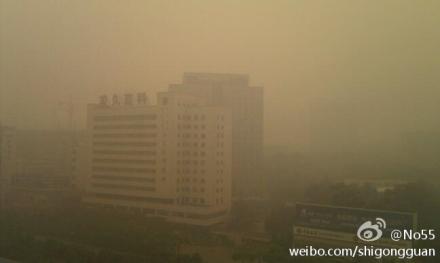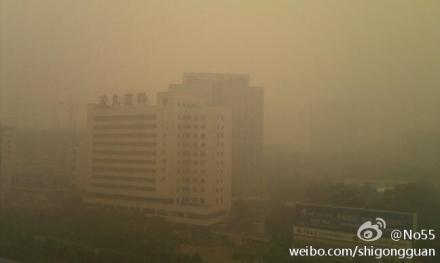This is what residents of the Chinese province of Wuhan woke up to yesterday.
At about 2 a.m. local time Monday morning, a dense smog began to cover the province. By early afternoon, it reached its peak density in the land-locked city of Wuhan itself.
People posted numerous photos of the haze on Weibo, the Chinese equivalent to Twitter. One blogger described her friends in the city darkly joking about being turned into Incredible Hulks.

What makes this smog dangerous isn’t that people will be transformed into giant, furious, off-color mutants, probably. The demonstrable danger is to lungs and bloodstreams.
The air in Wuhan was thick with tiny particles. Safety measurements of airborne particulate matter generally assess two different speck sizes: larger particles of about 10 micrometers (one-ten thousandth of a centimeter) in diameter, known as PM 10 (particulate matter 10), and smaller particles of 2.5 micrometers or smaller, known as PM 2.5. The smaller particles are much more dangerous since, when inhaled, they travel more easily throughout the body.
The United States sets a 24-hour limit on PM 10 pollution of 150 micrograms per cubic meter; for the more troublesome PM 2.5, the limit is 35. In Wuhan yesterday, PM 10 measured 574 and PM 2.5 was at 610.

Image via Weibo.
Early in the day, it wasn’t clear what was causing the choking haze. Rumors spread that a chlorine plant had exploded. The top post on Weibo about the city is still a reference to this rumor. As poorly translated by Google:
today in Wuhan chlorine factory explosion “ please note that closed off the window, at home, put a basin of water, air conditioning exhaust ~ The Air is polluted with sulfuric acid: H2SO4 nitric acid: HNO3 from factories in wuhan
Chinese authorities offer a more likely reason: farmers in rural areas burning straw — activity that had the same effect on the air quality of Shanghai over the weekend. Given the high levels of particulate matter, that explanation is far more likely than a toxic gas leak. Authorities were deliberate in quashing the chlorine plant rumor; at least one report indicates that two men sharing the chlorine plant explosion story were arrested.
There have also been efforts to downplay the situation. China Daily posted photos of Wuhan’s “heavy fog,” a claim challenged by commenters:
If that’s “fog,” why are those women wearing surgical masks? Fog is not brown. This must not be a Wuhan “blue-sky day.”
Fog is small water droplets, it is WET, that is brown and appears dry, I would call it filthy SMOG, I have been to WUHAN.
This morning, the American embassy released a statement suggesting that the pollution was likely to remain a problem (“recent weather conditions have not been good for the dispersion of pollutants”) and reiterating that burning vegetation was likely to blame.
No reports from Wuhan of Hulks. As yet.
[Credit to Abe Sauer for many of the links above.]




